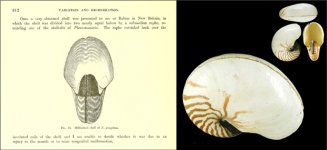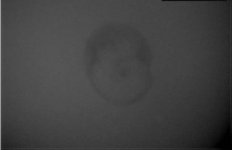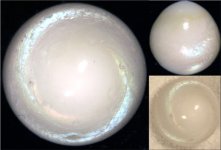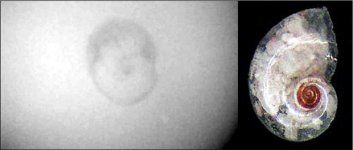The monograph mentions 5 pearls from Nautilus pompilius, and one from Argonauta hians. Only three of these pearls were from Hubert Bari. Were the other pearls identified as tridacna pearls too?
The three pearls in Bari are clearly either
Tridacna sp. or some sort of white conch due to their crossed-lamellar appearance. I must also say that they are from the collection of a UAE pearl dealer known to be a major producer, on his Australian farm, of the fraudulent natural-beaded pearls that have been flooding the natural market in the past two years (subject of Thomas Hainschwang's talk at AGA in Tucson last week).
Bari also received erroneous information regarding the biology of Nautilus, attributing its daily vertical migration to a change in buoyancy (like Nemo's
Nautilus), when it has been known to Nautilus experts for decades that Nautilus buoyancy adjusts far too slowly to account for this. As Bari himself has told me, he regrets inclusion of the chapter as premature. But it was far too tempting, and seemingly sure, at the time.
The other two pearls are those promoted by Tom Stern here, and they are quite likely Nautilus based on appearance, although there is evidence of flame structure that is worrisome. Only a close look under SEM, interpreted by Antonio Checa at U. Granada and Michael Vendrasco at UC Santa Barbara Institute for Crystal Studies (currently the only published/qualified scientists familiar with the microstructure in question) would be able to provide a definitive determination.
Argonauta (single-species cephalopod genus) is particularly interesting, as it takes the challenge of Nautilus to another level. With Nautilus, skeptics point to the differing appearance of the pearls and the shell.
Argonauta has no shell. It is the 'paper Nautilus', producing an extremely fragile, calcitic eggcase that certainly has nothing to do at all with any pearl associated with the mollusk. Therefore, a legitimate, aragonitic pearl from Argonautilus must originate in a part of the mollusk other than the mantle (GI or reproductive tract, muscle tissue, etc). As it is, the provenance for Tom's
Argonauta pearl is in severe doubt, as it was found loose in an old eggcase.
Finally, this thread has been blessed with the contribution of Dave at Lagoon Island Pearls, who physically harvested a calcareous pearl from an octopus, reporting it here with image.
It seems we have a wonderful opportunity, if Dave and Tom would offer their octopus and paper Nautilus pearls to compare with a Nautilus or two of reliable provenance, to check for genetic similarities among the cephalopods. By linking them, and differentiating them via their microstructure, some conclusions might be reached.




